Canada imports rose 3.9% to CAD 56.1B in February. Gains were observed in 9 of 11 import product sections. Exports rose 2.8% to CAD 58.7B, with increases in 8 of 11 products sections. Trade surplus narrowed from CAD 3.1B to CAD 2.7B, smaller than expectation of CAD 2.9B.
UK PMI services finalized at 62.6, second strongest since 1997
UK PMI Services was finalized at 62.6 in March, up from February’s 60.5. Rate of expansion was the second strongest since May 1997, exceeded only by the post-lockdown recovery in May 2021. PMI composite was finalized at 60.9, up from prior months 59.9, fastest expansion since June 2021.
Tim Moore, Economics Director at S&P Global: “UK economic growth continued to surge higher in March after an Omicron-induced slowdown at the turn of the year… However, the near-term growth outlook weakened in March, with optimism dropping to its lowest since October 2020 as the war in Ukraine and global inflation concerns took a considerable toll on business sentiment.
“Service providers experienced the second-fastest rise in business expenses since this index began in 1996, driven by higher wages, energy bills and fuel prices. Soaring costs meant that output charges were increased to the greatest extent for more than 25 years in March. Many survey respondents commented that the full extent of the recent spike in their operating costs had yet to be passed on to customers.”
Eurozone PMI composite finalized at 54.9, greater risk of economy stalling or contracting
Eurozone PMI Services was finalized at 55.6 in March, up from February 55.5, hitting a 4-month high. However, PMI Composite was finalized at 54.9, down from prior month’s 55.5.
Looking at some member states, Ireland PMI composite rose to 5-month high at 61.0. France rose to 8-month high at 56.3. But Germany dropped to 55.1. Spain dropped to 53.1. Italy dropped to 52.1. PMI composite of Germany, Spain and Italy were all at 2-month low.
Chris Williamson, Chief Business Economist at S&P Global said: “The further reopening of the eurozone economy amid the fading Omicron wave has provided a welcome tailwind to business activity in March… However, the resilience of the economy will be tested in the coming months by headwinds which include a further spike in energy costs and other commodity prices due to Russia’s invasion of Ukraine, as well as worsening supply chain issues arising from the war and a marked deterioration in business optimism regarding prospects for the year ahead…
“The outlook for growth has therefore deteriorated at a time when the inflation outlook has worsened. A recession is by no means assured, as the extent to which the economy could suffer in the coming months will depend on the duration of the war and any changes to both fiscal and monetary policy. It certainly seems likely however that the solid expansion seen in March will prove hard to sustain and there is clearly a greater risk of the economy stalling or contracting during the second quarter.”
AUD/CAD upside breakout after RBA, pressing 0.95
Australian Dollar rises sharply after the hawkish twist in RBA statement. AUD/CAD’s strong break of 0.9460 resistance confirms resumption of whole rise from 0.8906. Near term outlook will now stay bullish as long as 0.9337 support holds. Sustained break of 61.8% projection of 0.8906 to 0.9460 from 0.9160 at 0.9511 will indicate further upside acceleration. Next target will be 100% projection at 0.9723.
More importantly, the current development affirms the case that medium term corrective fall from 0.9991 has completed at 0.8906. AUD/CAD could be ready to resume the whole up trend from 0.8058 (2020 low).
RBA stands pat, drop the patient stance
RBA keeps cash rate unchanged at 0.10% today as widely expected. The central bank dropped the line that “the Board is prepared to be patient as it monitors how the various factors affecting inflation in Australia evolve.” It’s seen as a sign that RBA is preparing the markets for an earlier rate hike.
In the forward guidance, RBA said “the Board has wanted to see actual evidence that inflation is sustainably within the 2 to 3 per cent target range before it increases interest rates.”. While inflation has picked up and further increase is expected, “growth in labour costs has been below rates that are likely to be consistent with inflation being sustainably at target.”
RBA concluded, “over coming months, important additional evidence will be available to the Board on both inflation and the evolution of labour costs. The Board will assess this and other incoming information as its sets policy to support full employment in Australia and inflation outcomes consistent with the target.”
BoJ Kuroda: Recent Yen moves somewhat rapid
BoJ Governor Haruhiko Kuroda told the parliament today that recent moves in Yen exchange way have been “somewhat rapid”. He added, “it’s extremely important for currency rates to move stably reflecting economic and financial fundamentals.”
“We will patiently maintain powerful monetary easing to support an economy still in the midst of recovering from the COVID-19 pandemic’s impact,” he reiterated.
“If long-term interest rates rise rapidly, we are ready to deploy such market operations,” Kuroda said, referring to the intervention to cap 10-year JGB yield at 0.25%.
BoE Cunliffe: We will need carefully to judge the risks on both sides
BoE Deputy Governor Jon Cunliffe said said in a speech that the UK economy entered 2022 “still affected by two major impacts of the path out of Covid – very high imported inflation, and a very tight labour market with strong pay growth.”
“While I recognise the risk of second-round effects and that further tightening of monetary policy might be necessary, I am not at present convinced that we will inevitably have to lean heavily and constantly against an embedding of an inflationary psychology as we progress through this challenging period and as the impact of higher commodity prices on real household incomes depresses activity.”
“Rather, we will need carefully to judge the risks on both sides, weighing the evidence on the evolution of domestic prices, wages, activity and employment as it emerges. The MPC’s next forecast will be the first opportunity since the invasion to do that,” he added.
ECB Vasle preaches getting out of negative rate by turn of the year
ECB Governing Council member Bostjan Vasle said the most important thing for him is to start the process of ending asset purchases “note very late in the year”, and “have the opportunity to be out of negative territory by the turn of the year.”
“We’re still expecting quite strong positive growth rates, and if that scenario materializes I don’t see any reasons why we wouldn’t continue with policy normalization after the turn of the year and go above zero with interest rates,” he said.
That’s “one element affecting my understanding of not only inflation, but especially inflation pressures which are in the pipeline at the moment,” Vasle said. “It also gives me additional insight into what’s happening in the labor market and how these expectations regarding wages will be formed in future months and quarters.”
“My expectation is that in a quarter or two we’ll see the peak of inflation and then a gradual easing by the end of the year,” he said. “The last inflation reading was indeed very high, but in the context of the conflict and the rising prices across various energy segments, it was something which wasn’t so unexpected.”
BoE Bailey: Crypto creates an opportunity for the downright criminal
BoE Governor Andrew Bailey criticized at a “Stop Scam” conference that’s cryptocurrencies created an “opportunity for the downright criminal.” He asked, “what do people committing ransom attacks usually demand payment in? The answer is crypto.”
He also lamented that cryptocurrency users act as though national rules do not apply to them. “Some crypto enthusiasts say they shouldn’t be covered by Russian sanctions because that’s not their world,” he said. “I’m sorry, it is your world. We’re all in the same world.”
Eurozone Sentix dropped to -18 in April, pushed into recession
Eurozone Sentix Investor Confidence dropped from -7.0 to -18.0 in April, much worse than expectation of -9.7. That’s also the lowest level since July 2020. Current Situation index dropped from 7.8 to -5.5, lowest since April 2021. Expectations index dropped from -20.8 to -29.8, lowest since December 2011.
Sentix said the Eurozone economy is “being pushed into recession by the Ukraine conflict and the accompanying sanctions and uncertainties.”
“Due to the still considerable dynamics in the inflation trend, investors do not expect the central bank to be able to come to the rescue with a looser, even more expansive monetary policy. The economy and the stock markets are thus left to their own devices. For many investors, this is a new experience with its own risks.”
Fed Williams: Balance sheet reduction can begin as soon in May
New York Fed President John Williams said in a speech that FOMC communicated “two important message” about the likely future course of monetary policy during March meeting, along with the rate hike.
Firstly, it expects that “ongoing increases in the target range will be appropriate” and “the median assessment of the appropriate level of the federal funds rate at the end of next year is expected to be somewhat above the median assessment of its longer-run level”.
Secondly, FOMC expects to “decide at a coming meeting when to begin reducing its holdings of securities”. He added, “I expect that this process of reducing the size of the balance sheet can begin as soon as the May FOMC meeting”.
“These actions should enable us to manage the proverbial soft landing in a way that maintains a sustained strong economy and labor market,” Williams said. “Both are well positioned to withstand tighter monetary policy. In fact, I expect the economy to continue to grow this year and for the unemployment rate to remain close to its current level.”
Fed Daly: The case for 50bps hike has grown
San Francisco Fed President Mary Daly told FT, the case for 50bps rate hike in May has grown. “The case for 50, barring any negative surprise between now and the next meeting, has grown,” she said. “I’m more confident that taking these early adjustments would be appropriate.”
Daly noted the US labor market was “very strong” and “tight to an unsustainable level”. “If you want a job in the United States, you can get one and you can probably get multiple jobs at this point,” she said. “If you’re an employer looking for workers, it’s hard to both hire them and retain them.”
ECB Schnabel: Continuing policy normalization path is appropriate course of action
ECB Executive Board member Isabel Schnabel said in a speech over the weekend, “a considerable part of inflation is likely to prove more persistent, however – to an extent that, without monetary policy adjustment, inflation risks settling above our 2% target over the medium term.”
There are three factors that could make inflations “sticky”. Firstly, strong demand is contributing to rising pipeline pressures. Secondly, supply-side shocks are turning inflationary. Thirdly, wage catch-up is becoming more likely.
She added that continuing the path of policy normalization is “the appropriate course of action.” But, “the speed of normalisation, in turn, will depend on the economic fallout from the war, the severity of the inflation shock and its persistence.”
“We have stressed the importance of optionality and data dependence in our March Governing Council decision: we expect to conclude net asset purchases under our asset purchase programme in the third quarter, as long as the incoming data support the expectation that the medium-term inflation outlook will not weaken. We will hike interest rates some time after, as appropriate in light of incoming data,” Schnabel reiterated.
US ISM manufacturing dropped to 57.1, corresponds to 2.9% annualized GDP growth
US ISM manufacturing dropped from 58.6 to 57.1 in March, below expectation of 58.4. Prices jumped from 75.6 to 87.1, above expectation of 76.0. Employment also rose from 52.9 to 56.3, above expectation of 53.7.
ISM said: “The past relationship between the Manufacturing PMI and the overall economy indicates that the Manufacturing PMI for March (57.1 percent) corresponds to a 2.9-percent increase in real gross domestic product (GDP) on an annualized basis.”
US NFP employment grew 431k, unemployment rate dropped to 3.6%
US non-farm payroll employment grew 431k in March, lower than expectation of 488k. Overall job growth averaged 562k per month in Q1, the same as the average monthly gain for 2021. Employment was still down by -1.6m, or -1.0%, from its prepandemic level in February 2020.
Unemployment rate dropped from 3.8% to 3.6%, better than expectation of 3.7%. Labor force participation rate rate little changed at 62.4%.
Average hourly earnings rose 0.4% mom, matched expectations.
Eurozone CPI rose to 7.5% yoy, core CPI up to 3.1% yoy
Eurozone CPI accelerated sharply from 5.9% yoy to record high at 7.5% yoy in March, above expectation of 6.5% yoy. Core CPI also rose from 2.7% yoy to 3.0% yoy, but missed expectation of 3.1% yoy.
Looking at the main components of Eurozone inflation, energy is expected to have the highest annual rate (44.7%, compared with 32.0% in February), followed by food, alcohol & tobacco (5.0%, compared with 4.2% in February), non-energy industrial goods (3.4%, compared with 3.1% in February) and services (2.7%, compared with 2.5% in February).
UK PMI manufacturing finalized at 55.2, hit by several headwinds simultaneously
UK PMI manufacturing was finalized at 13-month low of 55.2, down from February’s 58.0. S&P Global said new export orders contracted for the second month running. Inflationary pressures strengthened.
Rob Dobson, Director at S&P Global, said: “Manufacturers are being hit by several headwinds simultaneously, as supply shortages, greater caution among clients, escalating inflationary pressures, ongoing Brexit factors and rising geopolitical tensions all hamper the upturn. It is therefore little surprise that business optimism has slumped to a 14-month low.”
Eurozone PMI manufacturing finalized at 56.5, Ukraine war an ominous new headwind
Eurozone PMI Manufacturing was finalized at 56.5 in March, down from February’s 58.2, hitting a 14-month low. Looking at some member states, Germany PMI manufacturing dropped to 18-month low at 56.9. Italy dropped to 14-month low at 55.8. France dropped to 5-month low at 54.7.
Chris Williamson, Chief Business Economist at S&P Global said: “Just as the fading of the latest pandemic wave was creating a tailwind for the eurozone manufacturing recovery, with economies re-opening and supply chain bottlenecks easing, the war In Ukraine has created an ominous new headwind.”
US NFP unlikely to alter Fed hike
US non-farm payrolls report is expected to show 488k job growth in March. Unemployment rate is expected to tick down further from 3.8% to 3.7%. Average hourly earnings are expected to return to growth at 0.4% mom.
Looking at related data, ADP report showed 455k private job growth in the same month, which was strong. Four-week moving average of initial jobless claims dropped notably from 208.5k to 230.5k. The employment data from ISM indexes are not available yet.
Markets are pricing in more than 70% chance of a 50bps rate hike by Fed in May. Even a moderate miss in the headline NFP number is not going to alter such expectations much. On the other hand, solid wages growth would leave less room for the Fed doves to argue for a small hike.
Some previews on NFP:




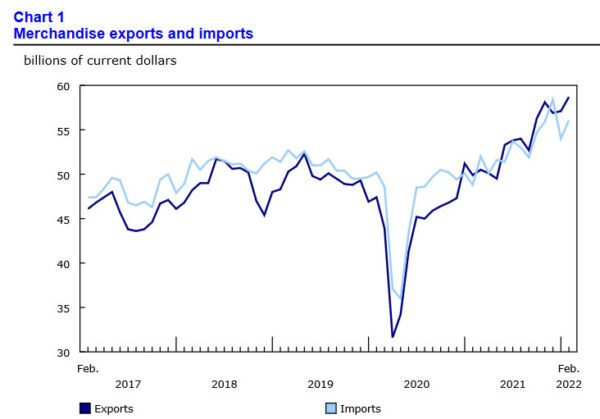
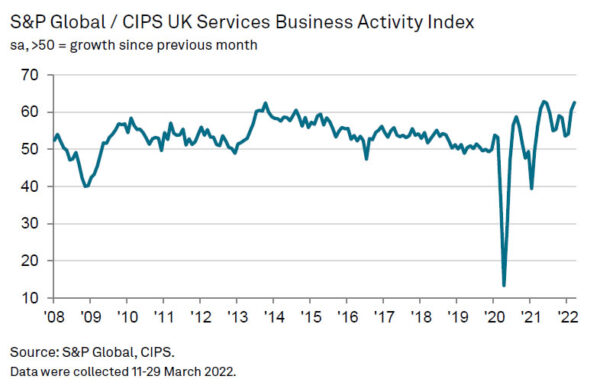
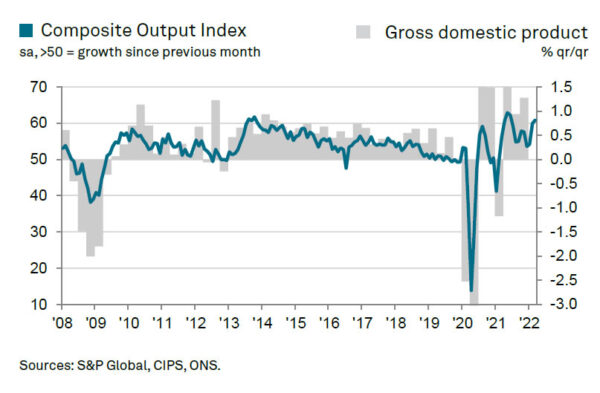
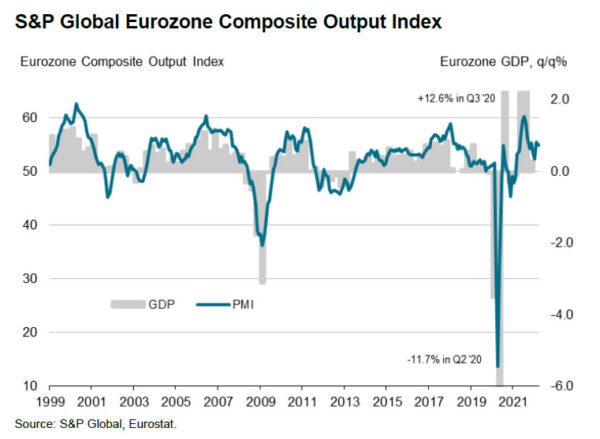
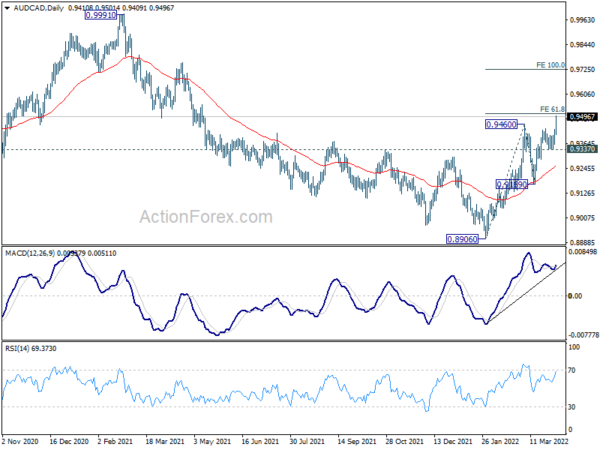
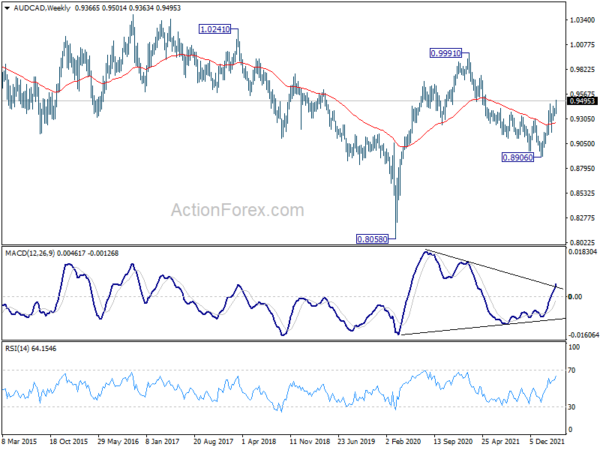
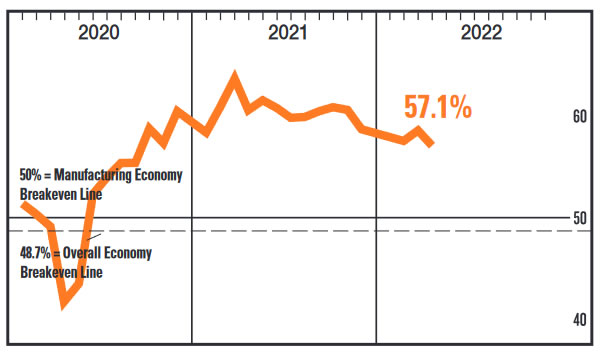
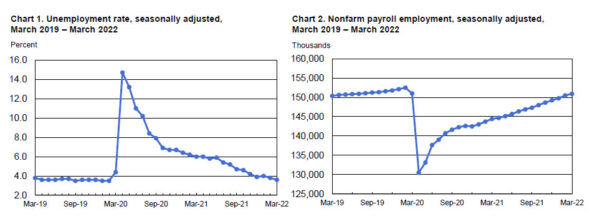
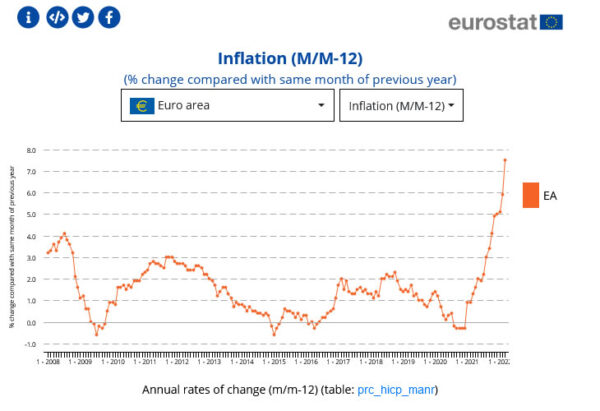
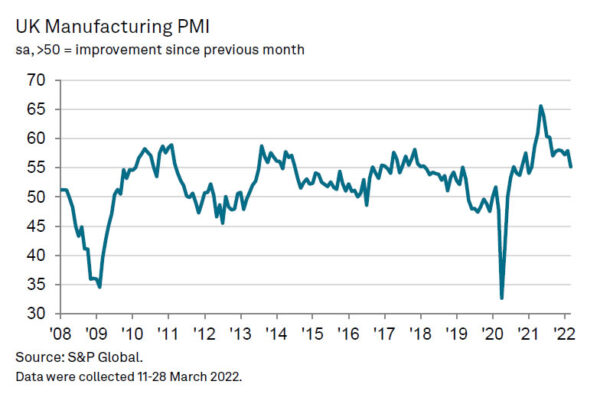
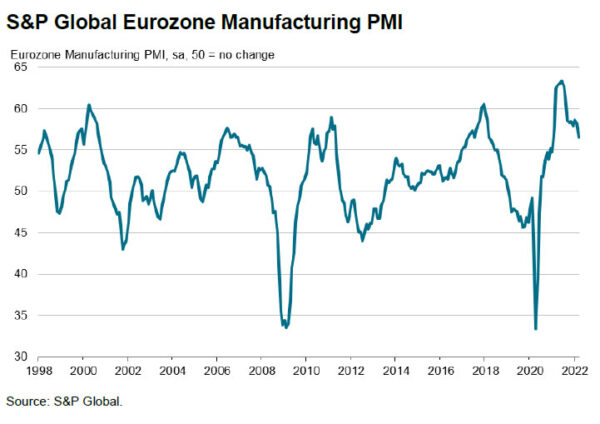

US trade deficit unchanged at US 89.2B in Feb
US exports of goods and services rose 1.8% to USD 228.6B in February. Imports of goods and services rose 1.3% to USD 317.8B. Trade deficit was relatively unchanged at USD 89.2B, larger than expectation of USD 88.5B.
Trade deficit with Mexico dropped USD 2.7B to USD 9.8B. Deficit with Japan dropped USD 2B to USD 5.1B. Deficit with China rose USD 7.9B to USD 41.2B.
Full release here.